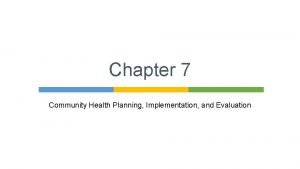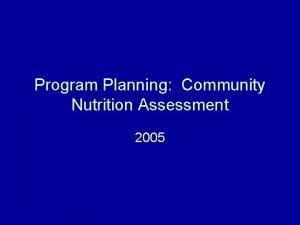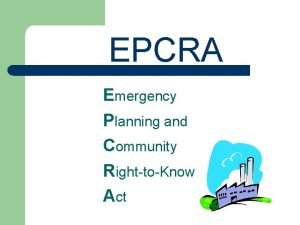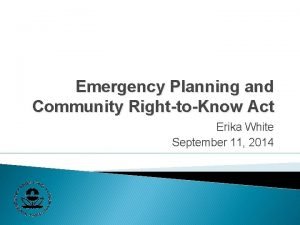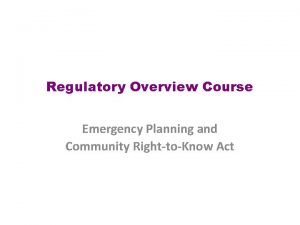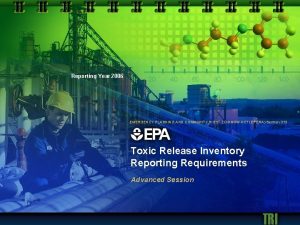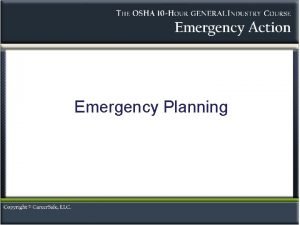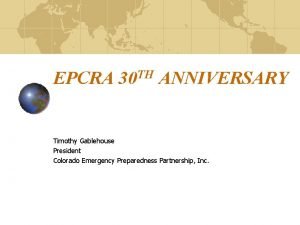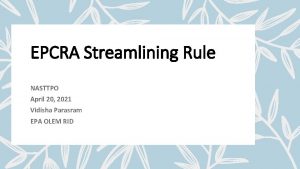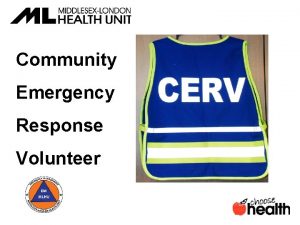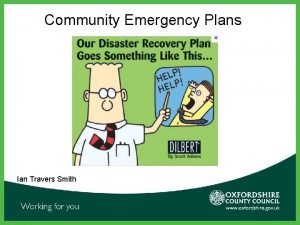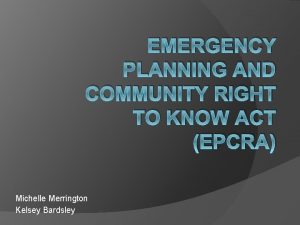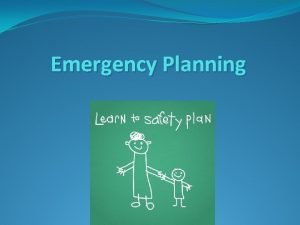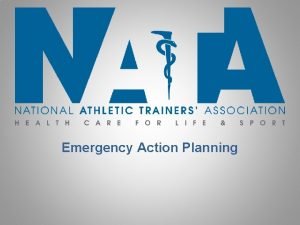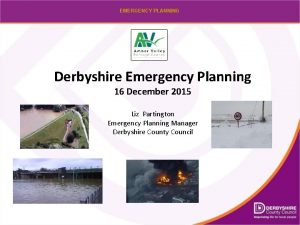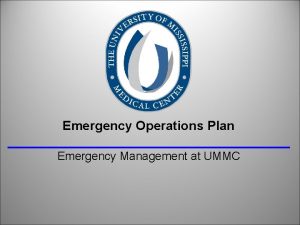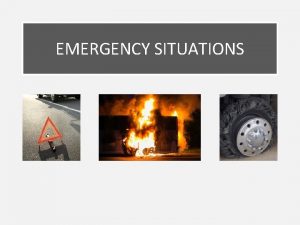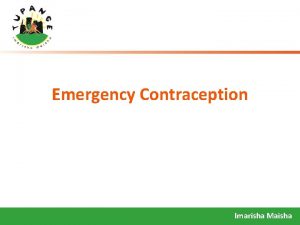Emergency Planning and Community RighttoKnow Act EPCRA The








































![EPCRA (SARA Title III) OSHA [29 CFR 1910. 1200(b)] Exemptions (1) Any hazardous waste EPCRA (SARA Title III) OSHA [29 CFR 1910. 1200(b)] Exemptions (1) Any hazardous waste](https://slidetodoc.com/presentation_image/3a26e751bb31d5149ca3bec800a57b52/image-41.jpg)
![EPCRA (SARA Title III) OSHA [(29 CFR 1910. 1200(b)] Exemptions (4) "Article means a EPCRA (SARA Title III) OSHA [(29 CFR 1910. 1200(b)] Exemptions (4) "Article means a](https://slidetodoc.com/presentation_image/3a26e751bb31d5149ca3bec800a57b52/image-42.jpg)
![EPCRA (SARA Title III) OSHA [29 CFR 1910. 1200(b)] Exemptions (5) Food, drugs, cosmetics, EPCRA (SARA Title III) OSHA [29 CFR 1910. 1200(b)] Exemptions (5) Food, drugs, cosmetics,](https://slidetodoc.com/presentation_image/3a26e751bb31d5149ca3bec800a57b52/image-43.jpg)
![EPCRA (SARA Title III) OSHA [29 CFR 1910. 1200(b)] Exemptions (7) Any consumer product EPCRA (SARA Title III) OSHA [29 CFR 1910. 1200(b)] Exemptions (7) Any consumer product](https://slidetodoc.com/presentation_image/3a26e751bb31d5149ca3bec800a57b52/image-44.jpg)
![EPCRA (SARA Title III) OSHA [29 CFR 1910. 1200(b)] Exemptions (8) Any drug as EPCRA (SARA Title III) OSHA [29 CFR 1910. 1200(b)] Exemptions (8) Any drug as](https://slidetodoc.com/presentation_image/3a26e751bb31d5149ca3bec800a57b52/image-45.jpg)
















- Slides: 61

Emergency Planning and Community Rightto-Know Act (EPCRA) The Ten. Thousand Foot Overview

What is EPCRA? ‣ Emergency Planning and Community Right-to -Know Act, also known as Title III of the Superfund Amendments and Reauthorization Act (SARA) of 1986 EPCRA establishes requirements for federal, state and local governments, Indian tribes, and industry regarding emergency planning and “Community Right-to. Know” reporting on hazardous and toxic chemicals. The Community Right-to-Know provisions help increase public’s knowledge and access to information on chemicals at individual facilities, their uses, and releases into the environment.

Why EPCRA? � Bhopal, India - December 3, 1984 o Union Carbide India Limited pesticide plant o Methyl isocyanate (MIC) gas was released into areas located near the plant. � A government report in 2006 stated the leak caused 558, 125 injuries; including 38, 478 temporary injuries and approximately 3, 900 severely and permanently disabling injuries

What Does EPCRA Cover? � EPCRA has four major provisions: ◦ Emergency planning (sections 301 -303) ◦ Emergency release notification (section 304) ◦ Hazardous chemical reporting requirements (sections 311 -312) ◦ Toxic chemical release inventory (section 313) � Information collected from these four requirements helps states and communities develop a broad perspective of chemical hazards for the entire community � Regulations implementing EPCRA are codified in Title 40 of the Code of Federal Regulations, parts 350 to 372

Community Awareness � EPCRA requires facilities manufacturing, storing or processing certain chemicals to report usage and spill data. o Must report to EPA, state and local governments and tribes o Data is publicly available from the state and county, unless it is protected by a valid trade secret claim.

EPCRA is a Partnership! � It is the facility’s responsibility to know and meet the requirements of the law. � It is the LEPC’s mission to assist the facility and work with them to develop an effective off-site plan. � It is WEM’s goal to supply the facility and LEPC with any assistance needed to help the facility voluntarily comply with the law.

Requirements of State � State (WEM) serves as the State Emergency Response Commission (SERC) � SERC or designee (WEM) responsibilities: o Assure each of Wisconsin’s 72 counties maintains a Local Emergency Planning Committee (LEPC) o Assist with the LEPCs’ activities o Review the local emergency response plans each year o Receive all chemical release notifications and inventory reports

EPCRA – WEM Responsibilities � Administer the program state-wide o Establish policy and guidance o Maintain state-wide EPCRA database of facility records on Wisconsin Haz. Mat On-line Planning and Reporting System (WHOPRS) o Process/verify fee payments (WEM 1 Admin. Rule) o Assure/enforce compliance (WEM 2 Admin. Rule) o Administer EPCRA grants to counties/LEPC’s o Outreach

Local Emergency Planning Committee (LEPC) � The County LEPC performs a critical community service that brings together individuals from a variety of disciplines with diverse levels of expertise in order to plan for and respond to chemical emergencies. It promotes the community’s right to know about chemicals present in or near their homes and places of business.

LEPC • Goals For LEPC Are Provided In EPCRA üProvide a basis for each community to develop a chemical emergency preparedness and planning program that suits individual needs üProvide the public with the identity, quantity, location, and properties of hazardous substances in the community (Sec. 311/312 Reporting) üProvide the community with data on annual releases of certain chemicals into the environment (Sec. 313 TRI Form R)(DNR)

LEPCs - Background • • • LEPCs were created in Wisconsin under the Hazardous Substances Information and Emergency Planning Act (April 1988) implementing EPCRA in Wisconsin under Wis. Stat. 323 - Emergency Management LEPC staff support from County Emergency Management Offices LEPC Membership representing: 1. Group 1: Elected State and local officials; 2. Group 2: Law enforcement, civil defense, firefighting, first aid, health, local environmental, hospital, and transportation personnel; 3. Group 3: Broadcast and print media; 4. Group 4: Community groups; 5. Group 5: Owners and operators of facilities subject to the requirements

Requirements of LEPC � LEPCs (county) responsibilities o Assure new and updated facility off-site plans are submitted as required under EPCRA Plan-of-Work (POW) o Must develop & maintain a county wide EPCRA plan o Collect and store information provided by facilities o Provide this information to the public as requested o Publish an annual notice for public access to open records o Training, exercising, planning, spill reporting, outreach

County Wide EPCRA Plan � Plan Requirements for county plan o Identification of facilities with and transportation routes of extremely hazardous substances o Description of emergency response procedures on and off-site o Designation of a community coordinator and facility coordinator to implement the plan o Outline of emergency notification procedures

County Wide Plan Requirements o Description of how to determine the probable affected area and population by releases o Outline of evacuation plans o Description of local emergency equipment and facilities and the persons responsible for them o Provision of a training program for emergency responders (including schedules) o Provide methods and schedules for exercising emergency response plans

Requirements of Facilities � � � (302) Submit Planning Notification for an Extremely Hazardous Substance (EHS) present at the facility at or above the Threshold Planning Quantity (TPQ) (303) Promptly supply the LEPC with information requested that is necessary to complete a facility off-site plan. (304) Emergency Release & Spill Reporting *(w/DNR) (311) Submit a chemical list or Safety Data Sheet (SDS) within 90 days of obtaining a reportable chemical (312) Submit annual Tier II Chemical Inventory Report by March 1 st annually � (WEM 1) Pay fees in Wisconsin, as applicable � (313) Toxic Release Inventory Form R Reporting (DNR) � Risk Management Program (RMP Planning)

Types of Facilities � Facilities with EPCRA EHS and/or hazardous chemicals can fall into one or both of these categories: o Tier II Reporting - hazardous chemicals at or above threshold quantities as specified by EPA and OSHA SDS (safety data sheet) under hazard communication standard. Report Mach 1 st annually. o Emergency Planning – Extremely Hazardous Substances (EHS) present at or above Threshold Planning Quantity (TPQ) that is determined by EPA’s List of Lists

� Wisconsin WHOPRS Haz. Mat On-line Planning and Reporting System o Customized version of IDSi’s* Tier II Manager software system used by 14 states, 10 state level programs, over 2, 700 local government agencies including LEPC, fire and Hazmat teams and over 350, 000 businesses o Used to manage the process of meeting EPCRA reporting, oversight and emergency response needs �Provides facilities an on-line, single point of submission for Tier II Reports and Emergency Planning Notifications (EPN) o Provides compliance administrators and first responders real-time access to critical hazardous chemical inventory and access to facility information *IDSi International is the sole developer, distributor, supplier, and maintenance provider for the Tier II Manager (WHOPRS).

Adding A Planning Facility – Sec. 302 Does the facility have an EHS Present at or above the TPQ? No Facility is exempt from Section 302 Planning Yes Complete Emergency Planning Notification Fee Statement (by WHOPRS or hardcopy) or a letter indicating that the facility is subject to Sec 302 Planning Does the facility Operator have 10 or more FTE employees In the State of Wisconsin? Yes Within 60 days of having an EHS at or above TPQ return the completed EPN or letter with remittance to WEM No Within 60 days of having an EHS at or above TPQ return the completed EPN or letter (declaring that they are fee exempt) Exempt )To WEM

EPCRA Section 303 Providing Emergency Planning Information Facility must provide the LEPC with information of a facility representative who will participate in the emergency planning process within 60 days of having an EHS at or above the TPQ. Facility must promptly provide information the LEPC requests which is necessary to develop & implement the facility off-site plan.

EPCRA Section 303 Providing Emergency Planning Information Facility must promptly notify the LEPC of relevant changes at the facility as they occur or are expected to occur (i. e. , change in # or qty. of EHS, etc. ) Wis. Stat. , 323. 60(5 m), Furnishing Information, if WEM or LEPC requests information in writing, facility must provide information in the manner it was requested.

LEPC Planning Overview EPCRA Section 302 -303 Planning Process for Facility Off Site Plans • Suggested Preplanning Information Requested From Facility Coordinator: ü Contact information (primary & alternate) ü Chemical inventory & storage locations ü SDS sheets for Extremely Hazardous Substances (EHS) ü EHS worksheet on largest container(s) & shipment ü Facility site map & sewer map ü On-site response resources & equipment ü Facility designated hazmat contractor ü Facility on-site emergency procedures ü Employee hazardous materials training

EPCRA (SARA Title III) Section 304 Emergency Notification of Release Wis. Stat. , 323. 60(5)(b), Wis. Stats. , requires the owner or operator of a facility to immediately provide verbal notice to the - National Response Center (800 -424 -8802) and WEM/DNR (800 -9430003), Menu option #1 and the LEPC for the release of a: CERCLA (Comprehensive Environmental Response Compensation and Liability Act) hazardous substance or EPCRA EHS which meets or exceeds the reportable quantity (RQ) and is released and/or has the potential for release off-site.

EPCRA (SARA Title III) Section 304 Emergency Notification of Release Transportation related releases are not exempt from Section 304. EPA has written that a transportation operator may call 911 or other locally designated emergency number (since they will not have all relevant State and local numbers), in order to satisfy the notification requirements.

EPCRA SECTION 304 INITIAL RELEASE NOTIFICATION To County LEPC • • Verbal: Phone call to County EM 24/7 number Coordinate with designated after hours answering point ***Call County LEPC in addition to calling NRC and WI DNR (1 -800 -943 -0003) Written: Mail correspondence to County LEPC address & the following information must be provided in writing: - date, time, location, and duration of the release; name of chemical(s) and quantity released; destination of release; actions taken to respond to or contain the release; who responded to release; known or anticipated acute or chronic health risks; and, where appropriate, advice regarding medical attention.

EPCRA (SARA Title III) Wisconsin Spill Reporting Requirements The DNR must be immediately notified of all discharges of hazardous substances that adversely impact or threaten to adversely impact public health, human welfare or the environment.

Elements of A Reporting Facility Sec. 311 & 312 Does this facility have present at any one-time, a hazardous chemical at or above 10, 000 lbs. , and/or an EHS present at or above 500 lbs. or the TPQ, whichever is lower? The facility is exempt form Sec. 311 and Sec. 312 Requirements. No Yes Is the facility required by OSHA to prepare or have available an SDS for chemicals and/or EHS. Yes Is the hazardous chemical(s) or EHS exempt from reporting under one or more of the Sec. 311(e), the 29 CFR 1910. 1200(b) [OSHA], or by the Petroleum Marketing Exemption? Yes An SDS/SDS Chemical List submission is not required for substances exempt from reporting and the facility does not have to file an annual Tier II submission. No Within 90 days of having a hazardous chemical and/or EHS present at facility at any one time at a reportable amount, an SDS or SDS Chemical list must be submitted to WEM. The submission can be made online in WHOPRS or by hard copy. If by hard copy, it should be accompanied by a cover letter including date that chemicals reached reportable quantity, facility name, facility address, owner name, owner address and FEIN. In addition, a Tier II Report Form must be submitted to WEM by March 1 st either through WHOPRS or by hard copy.

EPCRA (SARA Title III) Section 311 SDS/Chemlist Submission A Tier II Hazardous Chemical Inventory Report is an acceptable Section 311 Chemlist Submission of chemicals listed by common name with hazard categories, as long as it meets the 90 day submission requirement for Section 311.

Section 312 Wisconsin Tier II Reporting / Inventory Fee v An Inventory Fee Statement must be completed with the Annual Tier II Report v Tier II and Inventory Fee Statement must be submitted by March 1 st annually to WEM. Copies submitted by facility are available to LEPC and Local Fire Department on WHOPRS v Fee is based on the number & quantity of chemicals reported on the Tier II Report which are subject to Inventory Fee calculation 28

Section 312 Tier II Chemical Inventory Report When does an EHS meet Tier II Reporting requirements but not Planning requirements. Sulfuric acid is an EHS. It’s Threshold Planning Quantity (TPQ) is 1000 pounds. However, the Inventory/Tier II reporting requirements for an EHS are 500 pounds or the TPQ whichever is lower. If a facility has 750 pounds of Sulfuric Acid they will meet the Inventory/Tier II Reporting requirements but not the Planning requirements. 29

New EPA Written Interpretation Q&A for SDS (safety data sheet) What is the EPCRA news we want to share with you today? � December 2018 EPA memo (entitled Safety Data Sheets with New OSHA Physical and Health Hazard Classes and Tier II Reporting) providing clarification on the 2018 hazard class reporting requirements for Tier II reporting � Provides a crosswalk for facilities that only have older MSDS with 5 hazard classes into the new 24 hazard classes required � The 4 item Q/A section provides clarifications and new interpretations of EPCRA reporting requirements

New EPA Written Interpretation Q&A for SDS (safety data sheet) Q 1: If facilities only have the MSDSs for their chemicals before OSHA adopted the GHS classification, how should the facility report their chemicals using the new physical and health hazards? � A 1: New SDS are required to be provided for the first shipment of chemicals. If a facility is not receiving new shipments, they should request a current SDS from the manufacturer. If one is not available, they should use the crosswalk or use best judgement to report the physical or health hazards as provided on the MSDS. �

New EPA Written Interpretation Q&A for SDS (safety data sheet) � Q 2: What should a facility do if the new SDS changes the chemicals’ hazard classes? Should they rely on the new SDS information or report as they have previously? � A 2: Facilities may assume that the chemicals are re-evaluated and classified accurately by manufacturers and importers using the GHS classification system that OSHA adopted, and therefore rely on the SDSs to report the hazardous chemicals accordingly.

New EPA Written Interpretation Q&A for SDS (safety data sheet) � � Q 3: A facility stores two hazardous chemicals with similar properties, but that are manufactured by different companies. The SDS for one of the chemicals lists that it is hazardous but the SDS for the other chemical says it is non-hazardous. How should the facility report these chemicals? A 3: If the facility was reporting these two chemicals in prior years, EPA encourages the facility to report both chemicals as before. If the facility is reporting these chemicals for the first time and if the facility believes that both should be reported, then provide same hazards for both chemicals. In case of doubt, facilities may provide both SDSs to their SERC, LEPC and their fire department and a letter of explanation.

New EPA Written Interpretation Q&A for SDS (safety data sheet) � � Q 4: A facility is unable to obtain an SDS with new physical and health hazards, and therefore, is unable to determine which of the new physical and health hazards apply. The facility purchased this chemical more than 15 years ago and has a MSDS, but have been unsuccessful in obtaining an SDS because the manufacturer is no longer in business or is no longer manufacturing the chemical. A 4: Use the EPA crosswalk. Facilities that have hazardous chemicals purchased prior to June 1, 2015 (OSHA’s HCS 2012 compliance date) may use this crosswalk to report their hazardous chemicals with the new hazard categories that EPA published in June 2016.

New EPA Written Interpretation Q&A for SDS (safety data sheet) When does this take effect? ◦ This clarification document was posted on EPA’s website in December 2018 and is in effect now. How will this impact off-site planning in 2019 and forward? ◦ EPA has clarified that SDS are the source for reporting information. This may lead to changes in what a facility reports due to the chemical provider’s reevaluation of their chemical. Where can emergency managers find more information? ◦ This EPA guidance document is posted on our WEM EPCRA website at: (https: //dma. wi. gov/DMA/divisions/wem/preparedness/ fact_sheet_qsas_F_reporting_new_hazard_categories_on_ tier_ii_form_12 -03 -18. pdf)

NOTE: EPA replaced the existing five hazard categories (Fire, Sudden Release of Pressure, Reactive, Immediate, Delayed) with each specific hazard class listed in the revised OSHA Hazard Communication Standard (HCS), as well as adding four additional hazards. The table below shows the hazards that EPA has adopted from the revised HCS. The hazard categories identified on Tier I and Tier II forms were replaced with the hazards listed in this table. Facilities had to comply with reporting the new hazards on their Tier II inventory form for reporting year 2017, which were submitted by March 1, 2018.

EPCRA (SARA Title III) Five Section 311 (e) Exemptions (1) Any food, food additive, color additive, drug, or cosmetic regulated by Food & Drug Admin. (FDA) (2) Any substance present as a solid in any manufactured item to the extent exposure to the substance does not occur under normal conditions of use

EPCRA (SARA Title III) Five Section 311 (e) Exemptions (3) Any substance to the extent it is used for personal, family or household purposes, OR is present in the same form and concentration as a product packaged for distribution and use by the general public [form is the type of packaging] Note: The exemption extends to any substance packaged in the same form or concentration whether or not it is used for the same purpose as the consumer product. Sulfuric acid in car batteries as a consumer packaged product would be exempt from reporting but are not exempt from planning requirements.

EPCRA (SARA Title III) Five Section 311 (e) Exemptions (4) Any substance to the extent it is used in a hospital or other medical facility under the direct supervision of a technically qualified individual Note: In Wisconsin substances used in research facilities are not exempt

EPCRA (SARA Title III) Five Section 311 (e) Exemptions (5) Any substance to the extent it is used in routine agricultural operations [by the end user] OR is a fertilizer held for sale by a retailer to the ultimate customer
![EPCRA SARA Title III OSHA 29 CFR 1910 1200b Exemptions 1 Any hazardous waste EPCRA (SARA Title III) OSHA [29 CFR 1910. 1200(b)] Exemptions (1) Any hazardous waste](https://slidetodoc.com/presentation_image/3a26e751bb31d5149ca3bec800a57b52/image-41.jpg)
EPCRA (SARA Title III) OSHA [29 CFR 1910. 1200(b)] Exemptions (1) Any hazardous waste as defined by Solid Waste Disposal Act & RCRA (2) Tobacco or tobacco products (3) Wood or wood products
![EPCRA SARA Title III OSHA 29 CFR 1910 1200b Exemptions 4 Article means a EPCRA (SARA Title III) OSHA [(29 CFR 1910. 1200(b)] Exemptions (4) "Article means a](https://slidetodoc.com/presentation_image/3a26e751bb31d5149ca3bec800a57b52/image-42.jpg)
EPCRA (SARA Title III) OSHA [(29 CFR 1910. 1200(b)] Exemptions (4) "Article means a manufactured item, other than a fluid or a particle: - Which is formed to a specific shape or design during manufacture; and - Which has end use function(s) dependent in whole or in part upon its shape or design during end use; and - Which under normal conditions of use does not release more than very small quantities e. g. , minute or trace amounts, of a hazardous chemical [as determined by under paragraph (d) of this section (hazard determination)] ; and - Does not pose a physical or health risk to employees.
![EPCRA SARA Title III OSHA 29 CFR 1910 1200b Exemptions 5 Food drugs cosmetics EPCRA (SARA Title III) OSHA [29 CFR 1910. 1200(b)] Exemptions (5) Food, drugs, cosmetics,](https://slidetodoc.com/presentation_image/3a26e751bb31d5149ca3bec800a57b52/image-43.jpg)
EPCRA (SARA Title III) OSHA [29 CFR 1910. 1200(b)] Exemptions (5) Food, drugs, cosmetics, or alcoholic beverages in a retail establishment that are packaged for sale to consumers (6) Food, drugs, or cosmetics intended for personal consumption by employees while in the work place
![EPCRA SARA Title III OSHA 29 CFR 1910 1200b Exemptions 7 Any consumer product EPCRA (SARA Title III) OSHA [29 CFR 1910. 1200(b)] Exemptions (7) Any consumer product](https://slidetodoc.com/presentation_image/3a26e751bb31d5149ca3bec800a57b52/image-44.jpg)
EPCRA (SARA Title III) OSHA [29 CFR 1910. 1200(b)] Exemptions (7) Any consumer product or hazardous substance, as those terms are defined in the Consumer Product Safety Act and Federal Hazardous Substances Act respectively, where the employer can demonstrate it is used in the workplace in the same manner as normal consumer use and which results in a duration and frequency of exposure which is not greater than exposures experienced by consumers
![EPCRA SARA Title III OSHA 29 CFR 1910 1200b Exemptions 8 Any drug as EPCRA (SARA Title III) OSHA [29 CFR 1910. 1200(b)] Exemptions (8) Any drug as](https://slidetodoc.com/presentation_image/3a26e751bb31d5149ca3bec800a57b52/image-45.jpg)
EPCRA (SARA Title III) OSHA [29 CFR 1910. 1200(b)] Exemptions (8) Any drug as that term is defined in the Federal Food, Drug and Cosmetic Act, when it is in solid, final form for direct administration to the patient (i. e. , tablets or pills)

EPCRA (SARA Title III) Reporting Exemptions NOTE: If an EHS is exempt from Section 311/312 due to reporting exemptions under 311(e) or OSHA [29 CFR 1910. 1200(b)], the exemption does not apply to the Section 302 Planning Notification requirements. submit planning notification if needed

EPCRA Grants � Two grants available (administered) through the WEM EPCRA program o o Computer and Hazardous Materials Response Equipment Grant (up to $10, 000) EPCRA Planning Grant administered in conjunction with the EMPG Grant on an annual basis under the EPCRA Plan of Work (formula based grant funding for each of the 72 County LEPCs.

EPCRA Planning Grant Funding � Eligible Expenses: All expenses must support completion of the EPCRA plan of work and required LEPC activities. � Funding may be used for the following: staff salaries and fringe benefits, postage, copying/printing, telephone, office supplies, travel/training, EPCRA exercises, planning contractor costs, rent expenses, and disposable hazmat supplies (<$3000). � Eligible expenses must occur within the grant performance period (10/01/2018 to 09/30/2019).

EPCRA Planning Grant POW Ø EPCRA Countywide Strategic Plan, includes: § Promulgation statement § Hazard Analysis: • Updated list of planning and Tier II facilities • Identification of major transportation routes • List of most common EHS at fixed facilities § Hazmat Response Capability: • Identification of emergency response team • Updated resource list • Emergency response team procedures § Process for maintaining or increasing hazmat emergency response capability: �Hazmat training program �Local training efforts listed

EPCRA Planning Grant POW Ø Local Emergency Planning Committee (LEPC) Administrative Requirements: § LEPC membership LIST (meet requirements as listed in Grant Announcement) § LEPC established rules or by-laws addressing committee functions: • • Compliance Inspector Public notification of committee activities Public meetings Public comments Distribution of the emergency plan Procedures for receiving and processing public requests Publish Annual EPCRA Public Notice

EPCRA Planning Grant POW Ø LEPC Facility Off-Site Planning • Update of Off-Site Plans • Development of New Off-Site Plans Ø EXERCISING • EPCRA Exercise requirement (TT & FE or TT & FS in 4 -yr cycle 2016 -2020) Ø EPCRA OUTREACH �EPCRA Outreach Campaign: three (3) or more activities comprising the campaign (seminars, social media, emails)

Computer and Haz. Mat Response Equipment Grant � State Grant o Award is from the state’s general purpose revenue (GPR) �Money collected through facility fee payments �DOA (Dept. of Administration) determines amount of funds made available to WEM for grant �Award to counties is based on an approved equipment list o Counties with an eligible hazardous materials team are eligible for a maximum of $10, 000. o Counties without a hazardous materials team are eligible only for the computer portion of the grant. o Grant funds do require a match by the counties (80/20).

RMP Planning � Section 112(r) of the Clean Air Act Amendments requires EPA to publish regulations and guidance for chemical accident prevention at facilities that use certain hazardous substances. � Regulations and guidance are contained in the Risk Management Plan (RMP) rule. � The RMP rule requires facilities that use extremely hazardous substances to develop a Risk Management Plan (RMP).

RMP Planning � RMP Plans include: • Hazard assessment that details o the potential effects of an accidental release, o an accident history of the last five years, and o an evaluation of worst-case and alternative accidental releases scenarios • Prevention program that includes: o safety precautions and maintenance, o monitoring, and o employee training measures • Emergency response program that spells out: o emergency health care, o employee training measures, and o procedures for informing the public and response agencies (e. g. , the fire department) should an accident occur

RMP Amendments that may impact LEPCs with regulated RMP facilities in their county There are provisions in the revised RMP final rule that may impact LEPCs – q Spells out how regulated RMP facilities are to share hazardous chemical and vulnerability information and coordinate planning with emergency responders, LEPCs, and the community. q LEPCs will need to be available to discuss RMP with regulated facilities, but each the LEPC decides how to use the information provided by the regulated RMP facilities in their LEPC planning process (RMP facility is responsible for creating and maintaining their Risk Management Plan).

RMP Amendments that may impact LEPCs with regulated RMP facilities in their county q Ø LEPCs and local responders must be made aware of RMP facility exercise requirements and determine their level of participation. RMP facilities are to conduct a minimum of one notification drill per year, one tabletop every 3 years and one functional exercise every 10 years. The RMP facilities are required to coordinate the exercise schedule with the LEPC and local responders. The RMP final rule summarizes requirements for RMP facilities to provide information to the public and community about releases (public meetings).

EPCRA Legal References � Federal requirements: ◦ 42 U. S. C. 116 - EMERGENCY PLANNING AND COMMUNITY RIGHT-TO-KNOW � State of Wisconsin requirements: ◦ Wisconsin Statute 323. 60 – Emergency Planning and Community Right to Know Act ◦ Codified in 1988

Resources � An Information Guide Emergency Planning and Community Right-To-Know Act https: //dma. wi. gov/DMA/divisions/wem/about/epcr a/EPCRA_Booklet. pdf � EPCRA/CERCLA/CAA § 112(r) Consolidated List of Lists https: //www. epa. gov/epcracerclacaass 112 r-consolidated-lists-march-2015 -version � WEM EPCRA Webpage https: //dma. wi. gov/DMA/wem/preparedness/epcra

Local Emergency Planning Committee • Contact WEM EPCRA staff about the following: q q q q q EPCRA Plan Development EPCRA Outreach Activities EPCRA Facility Requirements EPCRA WHOPRS System EPCRA Compliance Actions EPCRA Planning Grant EPCRA Computer & Hazmat Equipment Grant LEPC Membership & Responsibilities HMEP Planning Subgrant

EPCRA Program Staff � EPCRA Compliance Susan Knudson (608) 242 -3224 Susan. Knudson@wisconsin. gov Dawn Morris (608) 242 -3225 Dawn. Morris@wisconsin. gov � � EPCRA Program Manager Dave Radisewitz (608) 242 -3300 David. Radisewitz@wisconsin. gov For Help with WHOPRS Helpdesk https: //whoprs. wisconsin. gov/Facility/Help. Desk. aspx

Questions?
 Act 1 act 2 act 3
Act 1 act 2 act 3 Ebra new deal
Ebra new deal Assessment planning implementation and evaluation
Assessment planning implementation and evaluation Proactive planning and reactive planning
Proactive planning and reactive planning Long medium and short term planning in primary schools
Long medium and short term planning in primary schools Corpus planning and status planning slideshare
Corpus planning and status planning slideshare Hình ảnh bộ gõ cơ thể búng tay
Hình ảnh bộ gõ cơ thể búng tay Lp html
Lp html Bổ thể
Bổ thể Tỉ lệ cơ thể trẻ em
Tỉ lệ cơ thể trẻ em Gấu đi như thế nào
Gấu đi như thế nào Tư thế worm breton là gì
Tư thế worm breton là gì Alleluia hat len nguoi oi
Alleluia hat len nguoi oi Các môn thể thao bắt đầu bằng tiếng đua
Các môn thể thao bắt đầu bằng tiếng đua Thế nào là hệ số cao nhất
Thế nào là hệ số cao nhất Các châu lục và đại dương trên thế giới
Các châu lục và đại dương trên thế giới Công thức tính độ biến thiên đông lượng
Công thức tính độ biến thiên đông lượng Trời xanh đây là của chúng ta thể thơ
Trời xanh đây là của chúng ta thể thơ Cách giải mật thư tọa độ
Cách giải mật thư tọa độ Làm thế nào để 102-1=99
Làm thế nào để 102-1=99 Phản ứng thế ankan
Phản ứng thế ankan Các châu lục và đại dương trên thế giới
Các châu lục và đại dương trên thế giới Thơ thất ngôn tứ tuyệt đường luật
Thơ thất ngôn tứ tuyệt đường luật Quá trình desamine hóa có thể tạo ra
Quá trình desamine hóa có thể tạo ra Một số thể thơ truyền thống
Một số thể thơ truyền thống Cái miệng bé xinh thế chỉ nói điều hay thôi
Cái miệng bé xinh thế chỉ nói điều hay thôi Vẽ hình chiếu vuông góc của vật thể sau
Vẽ hình chiếu vuông góc của vật thể sau Nguyên nhân của sự mỏi cơ sinh 8
Nguyên nhân của sự mỏi cơ sinh 8 đặc điểm cơ thể của người tối cổ
đặc điểm cơ thể của người tối cổ Thế nào là giọng cùng tên
Thế nào là giọng cùng tên Vẽ hình chiếu đứng bằng cạnh của vật thể
Vẽ hình chiếu đứng bằng cạnh của vật thể Phối cảnh
Phối cảnh Thẻ vin
Thẻ vin đại từ thay thế
đại từ thay thế điện thế nghỉ
điện thế nghỉ Tư thế ngồi viết
Tư thế ngồi viết Diễn thế sinh thái là
Diễn thế sinh thái là Dot
Dot Số nguyên tố là số gì
Số nguyên tố là số gì Tư thế ngồi viết
Tư thế ngồi viết Lời thề hippocrates
Lời thề hippocrates Thiếu nhi thế giới liên hoan
Thiếu nhi thế giới liên hoan ưu thế lai là gì
ưu thế lai là gì Khi nào hổ mẹ dạy hổ con săn mồi
Khi nào hổ mẹ dạy hổ con săn mồi Sự nuôi và dạy con của hươu
Sự nuôi và dạy con của hươu Hệ hô hấp
Hệ hô hấp Từ ngữ thể hiện lòng nhân hậu
Từ ngữ thể hiện lòng nhân hậu Thế nào là mạng điện lắp đặt kiểu nổi
Thế nào là mạng điện lắp đặt kiểu nổi Community action cycle for community mobilization
Community action cycle for community mobilization Community nutrition program planning
Community nutrition program planning Physical spatial approach in tourism planning
Physical spatial approach in tourism planning Modifiers of human act passion
Modifiers of human act passion Ra 9344
Ra 9344 Strategic planning vs tactical planning
Strategic planning vs tactical planning Planning balance sheet in urban planning
Planning balance sheet in urban planning Role segmentation workforce planning
Role segmentation workforce planning Perencanaan agregat ppt
Perencanaan agregat ppt Aggregate planning is capacity planning for
Aggregate planning is capacity planning for Capacity aggregation example
Capacity aggregation example Summary of othello act 1 scene 1
Summary of othello act 1 scene 1 Summary of act 4 of macbeth
Summary of act 4 of macbeth Example of imperfect voluntary act
Example of imperfect voluntary act


